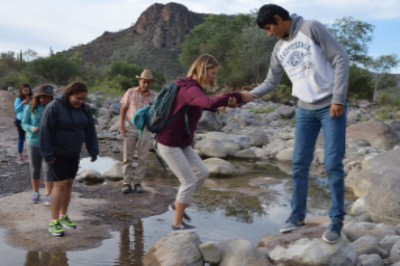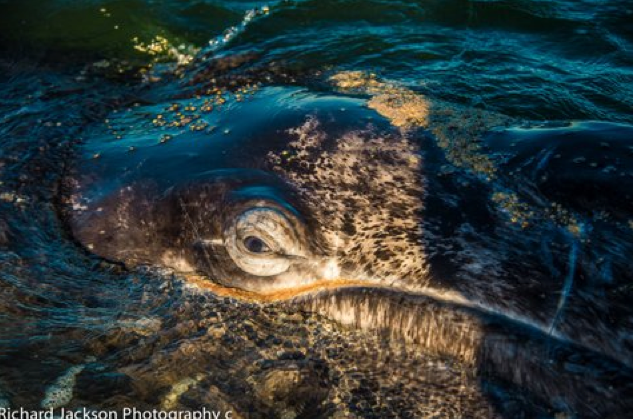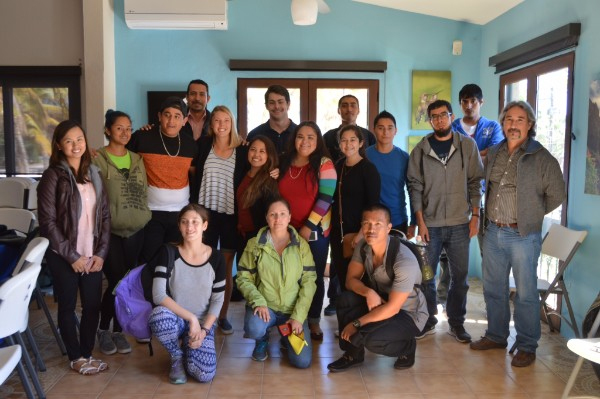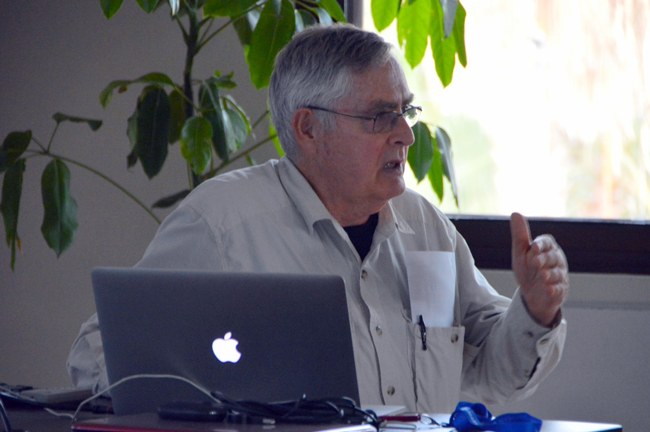Happy New Year to You and Yours from All of Us at Eco-Alianza!
With this issue of Soundings, Eco-Alianza enters its tenth year of operations, a significant marker for any non-governmental organization. Sadly, most non-profits flame out or fizzle within their first few years. Eco-Alianza’s vitality and steady growth is a testament to the commitment and perseverance of Eco-Alianza staff and supporters like you. We welcome the opportunity to continue working for solutions to the many enduring challenges engendered in our mission.
Read below about some of the ways we bring people together ~ welcoming them to join our ongoing celebration of the wondrous qualities of Loreto’s environment and culture. Here’s to hoping our next 10 years are as magical as the first!
Eco-Alianza Facilitates Fourth Visit by San Diego State Student Researchers
Eco-Alianza’s relationship with professors and students from San Diego State University continues to grow, as the visiting research team has just completed a fourth trip to Loreto.

Students from SDSU and UABCS work together on research and cooperate during visits to sites including this outing to San Javier. Staff photo
Hugo Quintero, Eco-Alianza’s Executive President, says this partnership originally began with inquiries from SDSU professor Paul Ganster, who was part of a research and writing team that published the 2007 book “Loreto, The Future of the First Capital of the Californias.” Ganster was seeking an NGO with which to partner as he and his team work on creating a revised and updated edition of the book. Eco-Alianza fit the bill perfectly.
The book, in English and Spanish, covers history as well as a wide variety of social science and natural science topics, complete with ongoing scientific studies about Loreto’s unique culture.
With direction from professors, students conduct social science surveys regarding visitors’ and locals’ perceptions of Loreto, the ways in which it is growing, the trends in tourism, the quality of life, and a wide variety of other topics that were addressed in the book’s first edition. Eco-Alianza facilitates visits to local sites where additional research is conducted, presents various workshops, and handles the logistics of the visits.
The visits have evolved into somewhat of an international exchange, as students from UABCS in Loreto and UABCS in La Paz also take part in the research on natural resources, evolving projects, and social science. During this trip, five students from Loreto and two from La Paz joined the eight who came from San Diego.
Hugo sees the project as potentially a prototype for a program supporting researchers from around the world, especially research teams attached to universities. In the future, he says, it’s possible that we’ll be able to involve the community more closely, perhaps housing visitors with local families to make their visits even more personal.
Bat Study Published in Mammalogy Journal

Notice how the pallid bat’s ears and chest are stained from the fruit of the cardon. Photograph courtesy of Jaclyn Aliperti
If you haven’t picked up the January edition of the Journal of Mammalogy, you’ve missed a fascinating article prompted in part by intense bat research here in Loreto.
Jaclyn Aliperti, a big fan of Loreto, teamed up with Paul Heady and Dr. Winifred Frick, who have a house here, and one additional scientist for the scientific paper. You may recognize Dr. Frick’s name as she’s recently joined Eco-Alianza’s advisory board and is the Senior Director for Conservation Science with Bat Conservation International (BCI). She also presented a wonderful bat program at CenCoMA as part of last year’s “Visiting Scientist” series.
The joint study and article focus on the pallid bat, best known for its primary diet of scorpions and other arthropods. The study proves that at certain times of the year, pallids also gorge themselves on the fruit of the cardon cactus. And because they don’t have long snouts like lots of fruit-eating bats, they have to jam themselves into the fruit, getting it all over themselves. They are potential seed dispersers and pollen spreaders for this important species of cactus in the Sonoran Desert. The method of proving all this includes testing their breath and also capturing them on video.
Check out the cool video on the BCI website:
http://www.batcon.org/resources/media-education/news-room/the-echo/1033-messy-eater-a-boon-for-cactus-fruit?highlight=WyJwYWxsaWQiLCJiYXQiLCJwYWxsaWQgYmF0Il0=
How do you test a bat’s breath? Learn how from the article:
https://academic.oup.com/jmammal/article/2770523/Using-behavioral-and-stable-isotope-data-to
2017 Sister Parks Calendar Now Available
It’s not too late to commemorate our three-year effort to establish the official Sister Parks relationship between Parque Nacional Bahía de Loreto and Channel Islands National Park in Ventura, CA, by purchasing your Sister Parks calendar.
The potential for shared resources and shared expertise from the sisterhood remains promising, and is one of the reasons Eco-Alianza strongly pushed for inclusion in the U.S. Park Service’s Sister Parks Program. The calendar features beautiful images of both parks, by Rick Jackson and other talented photographers. Please support this effort!
The calendar also lists all major Mexican, Canadian, American, and religious holidays (as well as phases of the moon and other pertinent information). All proceeds support Eco-Alianza’s environmental education programs here in Loreto. Calendars are $10USD or $180MXP. Calendars are available (limited supplies) in Loreto Bay at Corazón Café and the Agua Viva Management Office, and in Loreto at Gecko’s Curios, Eco-Alianza’s CenCoMA office, Blue Anchor, Ferremar, Sea Coffee, El Gavilan, Roxana, Caballo Blanco, Museo, and Turismo.
Or order one online and we’ll mail it to you or a friend!
The perfect gift: $10USD plus shipping. https://ecoalianzaloreto.org/calendar/
Eco-Alianza Embarks on 10th Anniversary Year

Eco-Alianza’s tenth year is an occasion worth celebrating! Photograph courtesy of Richard Jackson Photography
Yes, you read that right! It may seem like only yesterday, but 2017 marks Eco-Alianza’s 10th year of working to protect the environment and enhance the culture of Loreto and the central Baja peninsula.
Throughout the year we’ll be glancing back at how you’ve helped us reach milestones and succeed along the way. Watch this space, or send us your recollections for publication here and on our Facebook page.
And remember to mark Saturday, November 18 on your calendar for our 10th Anniversary celebration and dinner/auction. The event was originally scheduled for earlier in November, but at the request of many potential attendees we’ve pushed it back. The date is now firm, so please plan to join us for some awesome FESTIVITIES!
Loreto Suitable for Old and Young Alike

Tranquil neighborhoods and clean streets set the tone for a visit to Loreto. Photograph courtesy of Andrew Maxwell
It seems that nearly every month now, new visitors are drawn to Loreto to explore the idea of bringing groups here, or to consider Loreto as a potential venue for one project or another. And now, with the airing of the recently-produced “El Bienamado” telenovela filmed in Loreto, national and international exposure will likely increase.
Part of Eco-Alianza’s role is to encourage not just tourism, but green tourism. Visitors who use Loreto as a teaching venue and to appropriately explore natural wonders bring financial resources to the area, and leave with great stories, memories, and knowledge.
Just a few weeks ago, our staff helped encourage two teachers from our Sister City of Ventura, CA, who are considering Loreto as a venue for school trips — elementary school trips!
Andrew Maxwell and Ricardo Pinedo are educators at Will Rogers Elementary in Ventura, which is a K-5 “two-way immersion school of environmental science,” says Andrew. In other words, there is a continuing focus on environmental science, and classes are taught in a combination of English and Spanish. Fifth-graders currently take a class trip to the aquarium in Long Beach, and fourth-graders study the Camino Real and the chain of Missions.
Inspired by the Sister City project, the school’s PTA sent the two educators to check out Loreto, and Eco-Alianza staff gave them a whirlwind tour of San Javier, Isla Coronados, a local elementary school, our CenCoMA headquarters, the downtown Mission, and sites around town.
Like many visitors, Andrew said he and Ricardo both were struck with the town’s tranquility, feeling of safety, cleanliness, and the friendliness of Loretanos. He said they will “absolutely” be considering the school trip concept further, perhaps beginning with a letter writing exchange.









